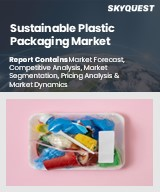
|
시장보고서
상품코드
1676212
세계의 제로 웨이스트 포장 시장 조사 보고서 : 산업 분석, 규모, 점유율, 성장, 동향 및 예측(2025-2033년)Global Zero Waste Packaging Market Research Report- Industry Analysis, Size, Share, Growth, Trends and Forecast 2025 to 2033 |
||||||
세계 제로 웨이스트 포장 시장 규모는 2024년 3,307억 1,000만 달러에서 2033년 7,971억 9,000만 달러에 달하고, 2026-2033년의 예측 기간 동안 10.27%의 견고한 연평균 성장률(CAGR)을 나타낼 것으로 예상됩니다.
제로 웨이스트 포장 시장은 소비자와 기업 모두 기존 포장재가 환경에 미치는 영향에 대한 인식이 높아지면서 성장세를 보이고 있습니다. 이 시장 특징은 폐기물을 최소화하고 순환 경제의 원칙을 촉진하는 지속 가능한 포장 솔루션으로의 전환입니다. 규제 압력과 친환경 제품에 대한 소비자 수요가 증가함에 따라 기업들은 재료 사용량을 줄이고 재활용성을 높이는 혁신적인 포장 디자인을 모색하고 있습니다. 생분해성, 퇴비화, 재사용이 가능한 포장 옵션의 채택은 브랜드가 지속가능성 목표에 부합하는 실천을 추구함에 따라 이 부문의 큰 성장을 가속할 것으로 예상됩니다.
기술의 발전은 제로 웨이스트 포장 시장의 발전에 있어 매우 중요한 역할을 하고 있습니다. 재료 과학의 혁신은 지속가능할 뿐만 아니라 기능적이고 심미적으로도 매력적인 새로운 포장재 개발로 이어지고 있습니다. 예를 들어, 식물성 고분자 및 재활용 재료의 사용이 확산되고 있으며, 기업은 버진 플라스틱에 대한 의존도를 줄일 수 있습니다. 또한, 포장 디자인 및 엔지니어링의 발전으로 운송 및 보관 시 폐기물을 최소화하고, 가볍고 공간 효율적인 포장 솔루션을 만들 수 있게 되었습니다. 시장이 성숙해짐에 따라 지속 가능한 재료의 연구 개발을 우선시하는 기업이 경쟁에서 우위를 점할 가능성이 높습니다.
또한, 제로 웨이스트 포장 시장은 소비자의 행동과 선호도에 점점 더 많은 영향을 받고 있습니다. 환경 문제에 대한 인식이 높아짐에 따라 소비자들은 지속가능성에 대한 노력을 보여주는 브랜드를 적극적으로 찾고 있습니다. 이러한 소비자 심리의 변화로 인해 기업들은 투명성 높은 관행을 채택하고 지속가능성에 대한 노력을 효과적으로 전달할 수 있도록 노력하고 있습니다. 지속가능성에 대한 노력을 고객과 소통하고 제로 웨이스트 포장 옵션을 제공하는 브랜드는 고객 충성도를 높이고 시장에서의 입지를 강화할 수 있습니다. 지속 가능한 포장에 대한 수요가 계속 증가함에 따라 제로 웨이스트 포장 시장은 확대될 것으로 예상되며, 공급망 전반에 걸쳐 혁신과 협업의 기회를 창출할 것으로 예상됩니다.
당사의 보고서는 고객에게 다양한 산업 및 시장에 대한 종합적이고 실용적인 통찰력을 제공하기 위해 세심하게 작성되었습니다. 각 보고서는 시장 상황을 완전히 이해하기 위해 몇 가지 중요한 요소를 포함하고 있습니다.
시장 개요: 시장 개요: 정의, 분류, 산업 현황에 대한 개요 등 시장에 대한 자세한 소개.
시장 성장 촉진요인: 시장 성장에 영향을 미치는 주요 촉진요인, 억제요인, 시장 성장 촉진요인 및 과제를 상세하게 분석합니다. 이 섹션에서는 기술 발전, 규제 변화, 새로운 트렌드 등의 요인을 검토합니다.
세분화 분석 : 제품 유형, 용도, 최종 사용자, 지역 등의 기준에 따라 시장을 명확한 부문으로 분류합니다. 이 분석을 통해 각 부문의 성과와 잠재력을 파악할 수 있습니다.
경쟁상황: 시장 점유율, 제품 포트폴리오, 전략적 이니셔티브, 재무실적 등 주요 시장 진입기업에 대한 종합적인 평가. 주요 기업들이 채택하고 있는 경쟁 역학 및 주요 전략에 대한 고찰이 포함되어 있습니다.
시장 예측 : 과거 데이터와 현재 시장 상황을 바탕으로 일정 기간 동안 시장 규모와 성장 추세를 예측합니다. 여기에는 정량적 분석과 미래 시장 궤적을 나타내는 그래프 표시가 포함됩니다.
지역 분석 : 지역별 시장 성과를 평가하고 주요 시장 및 지역 동향을 파악할 수 있습니다. 지역 시장 역학 및 비즈니스 기회를 이해하는 데 도움이 됩니다.
새로운 트렌드와 기회: 현재 시장 동향과 새로운 시장 동향, 기술 혁신, 잠재적 투자 대상 부문을 식별합니다. 미래 시장 개척 및 성장 전망에 대한 통찰력을 제공합니다.
목차
제1장 서문
제2장 주요 요약
- 시장 하이라이트
- 세계 시장 현황
제3장 제로 웨이스트 포장 산업 분석
- 서론 - 시장 역학
- 시장 성장 촉진요인
- 시장 성장 억제요인
- 기회
- 산업 동향
- Porter의 Five Forces 분석
- 시장의 매력 분석
제4장 밸류체인 분석
- 밸류체인 분석
- 원료 분석
- 원료 리스트
- 원료 제조업체 리스트
- 주요 원료 가격 동향
- 잠재적 바이어 리스트
- 마케팅 채널
- 직접 마케팅
- 간접 마케팅
- 마케팅 채널 발전 동향
제5장 세계의 제로 웨이스트 포장 시장 분석 : 재료별
- 재료별 개요
- 재료별 과거 및 예측 데이터 분석
- 바이오폴리머
- 종이 및 골판지
- 유리 포장
- 금속 포장
제6장 세계의 제로 웨이스트 포장 시장 분석 : 유형별
- 유형별 개요
- 유형별 과거 및 예측 데이터 분석
- 재이용 가능/재활용 가능 포장
- 퇴비화 가능 포장
- 식용 포장
제7장 세계의 제로 웨이스트 포장 시장 분석 : 유통 채널별
- 유통 채널별 개요
- 유통 채널별 과거 및 예측 데이터 분석
- 온라인
- 오프라인
제8장 세계의 제로 웨이스트 포장 시장 분석 : 용도별
- 용도별 개요
- 용도별 과거 및 예측 데이터 분석
- 식품 및 음료
- 의료
- 화장품 및 퍼스널케어
- 전기 및 전자
- 기타
- E-Commerce
제9장 세계의 제로 웨이스트 포장 시장 분석 : 지역별
- 지역별 전망
- 서론
- 북미의 판매 분석
- 개요, 분석과 예측
- 북미 : 부문별
- 북미 : 국가별
- 미국
- 캐나다
- 멕시코
- 유럽의 판매 분석
- 개요, 분석과 예측
- 유럽 : 부문별
- 유럽 : 국가별
- 영국
- 프랑스
- 독일
- 이탈리아
- 러시아
- 기타 유럽
- 아시아태평양의 판매 분석
- 개요, 분석과 예측
- 아시아태평양 : 부문별
- 아시아태평양 : 국가별
- 중국
- 인도
- 일본
- 한국
- 호주
- 동남아시아
- 기타 아시아태평양
- 라틴아메리카의 판매 분석
- 개요, 분석과 예측
- 라틴아메리카 : 부문별
- 라틴아메리카 : 국가별
- 브라질
- 아르헨티나
- 페루
- 칠레
- 기타 라틴아메리카
- 중동 및 아프리카의 판매 분석
- 개요, 분석과 예측
- 중동 및 아프리카 : 부문별
- 중동 및 아프리카 : 국가별 리스트
- 사우디아라비아
- 아랍에미리트(UAE)
- 이스라엘
- 남아프리카공화국
- 기타 중동 및 아프리카
제10장 제로 웨이스트 포장 기업 경쟁 구도
- 제로 웨이스트 포장 시장 경쟁
- 파트너십/제휴/합의
- 인수합병(M&A)
- 신제품 발매
- 기타 개발
제11장 기업 개요
- 주요 기업의 시장 점유율 분석
- 시장 집중도
- Ecovative LLC
- DS Smith Plc
- Avani Eco
- Biome Bioplastics Limited
- BIOPLA
- Loliware Inc.
- Evoware
- Sulapac Oy
- TIPA
- World Centric
- Notpla Limited
- Regeno
- Hero Packaging
Global Zero Waste Packaging Market size is anticipated to grow from USD 330.71 Billion in 2024 to USD 797.19 Billion by 2033, showcasing a robust Compound Annual Growth Rate (CAGR) of 10.27% during the forecast period of 2026 to 2033.
The Zero Waste Packaging market is gaining momentum as consumers and businesses alike become increasingly aware of the environmental impact of traditional packaging materials. This market is characterized by a shift towards sustainable packaging solutions that minimize waste and promote circular economy principles. As regulatory pressures and consumer demand for eco-friendly products rise, companies are exploring innovative packaging designs that reduce material usage and enhance recyclability. The adoption of biodegradable, compostable, and reusable packaging options is expected to drive significant growth in this sector, as brands seek to align their practices with sustainability goals.
Technological advancements are playing a pivotal role in the evolution of the Zero Waste Packaging market. Innovations in materials science are leading to the development of new packaging materials that are not only sustainable but also functional and aesthetically appealing. For instance, the use of plant-based polymers and recycled materials is becoming more prevalent, allowing companies to reduce their reliance on virgin plastics. Additionally, advancements in packaging design and engineering are enabling the creation of lightweight and space-efficient packaging solutions that minimize waste during transportation and storage. As the market matures, companies that prioritize research and development in sustainable materials will likely gain a competitive edge.
Furthermore, the Zero Waste Packaging market is increasingly influenced by consumer behavior and preferences. As awareness of environmental issues grows, consumers are actively seeking brands that demonstrate a commitment to sustainability. This shift in consumer sentiment is prompting companies to adopt transparent practices and communicate their sustainability efforts effectively. Brands that engage with their customers on sustainability initiatives and offer zero waste packaging options will foster loyalty and enhance their market position. As the demand for sustainable packaging continues to rise, the Zero Waste Packaging market is expected to expand, creating opportunities for innovation and collaboration across the supply chain.
Our reports are meticulously crafted to provide clients with comprehensive and actionable insights into various industries and markets. Each report encompasses several critical components to ensure a thorough understanding of the market landscape:
Market Overview: A detailed introduction to the market, including definitions, classifications, and an overview of the industry's current state.
Market Dynamics: In-depth analysis of key drivers, restraints, opportunities, and challenges influencing market growth. This section examines factors such as technological advancements, regulatory changes, and emerging trends.
Segmentation Analysis: Breakdown of the market into distinct segments based on criteria like product type, application, end-user, and geography. This analysis highlights the performance and potential of each segment.
Competitive Landscape: Comprehensive assessment of major market players, including their market share, product portfolio, strategic initiatives, and financial performance. This section provides insights into the competitive dynamics and key strategies adopted by leading companies.
Market Forecast: Projections of market size and growth trends over a specified period, based on historical data and current market conditions. This includes quantitative analyses and graphical representations to illustrate future market trajectories.
Regional Analysis: Evaluation of market performance across different geographical regions, identifying key markets and regional trends. This helps in understanding regional market dynamics and opportunities.
Emerging Trends and Opportunities: Identification of current and emerging market trends, technological innovations, and potential areas for investment. This section offers insights into future market developments and growth prospects.
SEGMENTATION COVERED IN THE REPORT
By Material
- Biopolymer
- Paper and Cardboard
- Glass Packaging
- Metal Packaging
By Type
- Reusable/Recyclable Packaging
- Compostable Packaging
- Edible Packaging
By Distribution Channel
- Online
- Offline
By Application
- Food & Beverages
- Healthcare
- Cosmetics & Personal Care
- Electrical & Electronics
- Others
- E-commerce
- COMPANIES PROFILED
- Ecovative LLC
- DS Smith plc
- Avani Eco
- Biome Bioplastics Limited
- BIOPLA
- Loliware Inc.
- Evoware
- Sulapac Oy
- TIPA
- World Centric
- Notpla Limited
- Regeno
- Hero Packaging
- The above list can be customized.
TABLE OF CONTENTS
1. PREFACE
- 1.1. Report Description
- 1.1.1 Objective
- 1.1.2 Target Audience
- 1.1.3 Unique Selling Proposition (USP) & offerings
- 1.2. Research Scope
- 1.3. Research Methodology
- 1.3.1 Market Research Process
- 1.3.2 Market Research Methodology
2. EXECUTIVE SUMMARY
- 2.1. Highlights of Market
- 2.2. Global Market Snapshot
3. ZERO WASTE PACKAGING INDUSTRY ANALYSIS
- 3.1. Introduction - Market Dynamics
- 3.2. Market Drivers
- 3.3. Market Restraints
- 3.4. Opportunities
- 3.5. Industry Trends
- 3.6. Porters Five Force Analysis
- 3.7. Market Attractiveness Analysis
- 3.7.1 Market Attractiveness Analysis By Material
- 3.7.2 Market Attractiveness Analysis By Type
- 3.7.3 Market Attractiveness Analysis By Distribution Channel
- 3.7.4 Market Attractiveness Analysis By Application
- 3.7.5 Market Attractiveness Analysis By Region
4. VALUE CHAIN ANALYSIS
- 4.1. Value Chain Analysis
- 4.2. Raw Material Analysis
- 4.2.1 List of Raw Materials
- 4.2.2 Raw Material Manufactures List
- 4.2.3 Price Trend of Key Raw Materials
- 4.3. List of Potential Buyers
- 4.4. Marketing Channel
- 4.4.1 Direct Marketing
- 4.4.2 Indirect Marketing
- 4.4.3 Marketing Channel Development Trend
5. GLOBAL ZERO WASTE PACKAGING MARKET ANALYSIS BY MATERIAL
- 5.1. Overview By Material
- 5.2. Historical and Forecast Data Analysis By Material
- 5.3. Biopolymer Historic and Forecast Sales By Regions
- 5.4. Paper and Cardboard Historic and Forecast Sales By Regions
- 5.5. Glass Packaging Historic and Forecast Sales By Regions
- 5.6. Metal Packaging Historic and Forecast Sales By Regions
6. GLOBAL ZERO WASTE PACKAGING MARKET ANALYSIS BY TYPE
- 6.1. Overview By Type
- 6.2. Historical and Forecast Data Analysis By Type
- 6.3. Reusable/Recyclable Packaging Historic and Forecast Sales By Regions
- 6.4. Compostable Packaging Historic and Forecast Sales By Regions
- 6.5. Edible Packaging Historic and Forecast Sales By Regions
7. GLOBAL ZERO WASTE PACKAGING MARKET ANALYSIS BY DISTRIBUTION CHANNEL
- 7.1. Overview By Distribution Channel
- 7.2. Historical and Forecast Data Analysis By Distribution Channel
- 7.3. Online Historic and Forecast Sales By Regions
- 7.4. Offline Historic and Forecast Sales By Regions
8. GLOBAL ZERO WASTE PACKAGING MARKET ANALYSIS BY APPLICATION
- 8.1. Overview By Application
- 8.2. Historical and Forecast Data Analysis By Application
- 8.3. Food & Beverages Historic and Forecast Sales By Regions
- 8.4. Healthcare Historic and Forecast Sales By Regions
- 8.5. Cosmetics & Personal Care Historic and Forecast Sales By Regions
- 8.6. Electrical & Electronics Historic and Forecast Sales By Regions
- 8.7. Others Historic and Forecast Sales By Regions
- 8.8. E-commerce Historic and Forecast Sales By Regions
9. GLOBAL ZERO WASTE PACKAGING MARKET ANALYSIS BY GEOGRAPHY
- 9.1. Regional Outlook
- 9.2. Introduction
- 9.3. North America Sales Analysis
- 9.3.1 Overview, Historic and Forecast Data Sales Analysis
- 9.3.2 North America By Segment Sales Analysis
- 9.3.3 North America By Country Sales Analysis
- 9.3.4 United States Sales Analysis
- 9.3.5 Canada Sales Analysis
- 9.3.6 Mexico Sales Analysis
- 9.4. Europe Sales Analysis
- 9.4.1 Overview, Historic and Forecast Data Sales Analysis
- 9.4.2 Europe By Segment Sales Analysis
- 9.4.3 Europe By Country Sales Analysis
- 9.4.4 United Kingdom Sales Analysis
- 9.4.5 France Sales Analysis
- 9.4.6 Germany Sales Analysis
- 9.4.7 Italy Sales Analysis
- 9.4.8 Russia Sales Analysis
- 9.4.9 Rest Of Europe Sales Analysis
- 9.5. Asia Pacific Sales Analysis
- 9.5.1 Overview, Historic and Forecast Data Sales Analysis
- 9.5.2 Asia Pacific By Segment Sales Analysis
- 9.5.3 Asia Pacific By Country Sales Analysis
- 9.5.4 China Sales Analysis
- 9.5.5 India Sales Analysis
- 9.5.6 Japan Sales Analysis
- 9.5.7 South Korea Sales Analysis
- 9.5.8 Australia Sales Analysis
- 9.5.9 South East Asia Sales Analysis
- 9.5.10 Rest Of Asia Pacific Sales Analysis
- 9.6. Latin America Sales Analysis
- 9.6.1 Overview, Historic and Forecast Data Sales Analysis
- 9.6.2 Latin America By Segment Sales Analysis
- 9.6.3 Latin America By Country Sales Analysis
- 9.6.4 Brazil Sales Analysis
- 9.6.5 Argentina Sales Analysis
- 9.6.6 Peru Sales Analysis
- 9.6.7 Chile Sales Analysis
- 9.6.8 Rest of Latin America Sales Analysis
- 9.7. Middle East & Africa Sales Analysis
- 9.7.1 Overview, Historic and Forecast Data Sales Analysis
- 9.7.2 Middle East & Africa By Segment Sales Analysis
- 9.7.3 Middle East & Africa By Country Sales Analysis
- 9.7.4 Saudi Arabia Sales Analysis
- 9.7.5 UAE Sales Analysis
- 9.7.6 Israel Sales Analysis
- 9.7.7 South Africa Sales Analysis
- 9.7.8 Rest Of Middle East And Africa Sales Analysis
10. COMPETITIVE LANDSCAPE OF THE ZERO WASTE PACKAGING COMPANIES
- 10.1. Zero Waste Packaging Market Competition
- 10.2. Partnership/Collaboration/Agreement
- 10.3. Merger And Acquisitions
- 10.4. New Product Launch
- 10.5. Other Developments
11. COMPANY PROFILES OF ZERO WASTE PACKAGING INDUSTRY
- 11.1. Top Companies Market Share Analysis
- 11.2. Market Concentration Rate
- 11.3. Ecovative LLC
- 11.3.1 Company Overview
- 11.3.2 Company Revenue
- 11.3.3 Products
- 11.3.4 Recent Developments
- 11.4. DS Smith Plc
- 11.4.1 Company Overview
- 11.4.2 Company Revenue
- 11.4.3 Products
- 11.4.4 Recent Developments
- 11.5. Avani Eco
- 11.5.1 Company Overview
- 11.5.2 Company Revenue
- 11.5.3 Products
- 11.5.4 Recent Developments
- 11.6. Biome Bioplastics Limited
- 11.6.1 Company Overview
- 11.6.2 Company Revenue
- 11.6.3 Products
- 11.6.4 Recent Developments
- 11.7. BIOPLA
- 11.7.1 Company Overview
- 11.7.2 Company Revenue
- 11.7.3 Products
- 11.7.4 Recent Developments
- 11.8. Loliware Inc.
- 11.8.1 Company Overview
- 11.8.2 Company Revenue
- 11.8.3 Products
- 11.8.4 Recent Developments
- 11.9. Evoware
- 11.9.1 Company Overview
- 11.9.2 Company Revenue
- 11.9.3 Products
- 11.9.4 Recent Developments
- 11.10. Sulapac Oy
- 11.10.1 Company Overview
- 11.10.2 Company Revenue
- 11.10.3 Products
- 11.10.4 Recent Developments
- 11.11. TIPA
- 11.11.1 Company Overview
- 11.11.2 Company Revenue
- 11.11.3 Products
- 11.11.4 Recent Developments
- 11.12. World Centric
- 11.12.1 Company Overview
- 11.12.2 Company Revenue
- 11.12.3 Products
- 11.12.4 Recent Developments
- 11.13. Notpla Limited
- 11.13.1 Company Overview
- 11.13.2 Company Revenue
- 11.13.3 Products
- 11.13.4 Recent Developments
- 11.14. Regeno
- 11.14.1 Company Overview
- 11.14.2 Company Revenue
- 11.14.3 Products
- 11.14.4 Recent Developments
- 11.15. Hero Packaging
- 11.15.1 Company Overview
- 11.15.2 Company Revenue
- 11.15.3 Products
- 11.15.4 Recent Developments



















